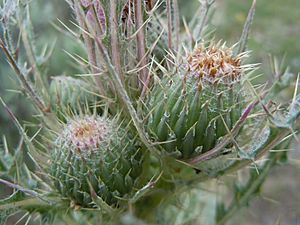Indian thistle facts for kids
Quick facts for kids Indian thistle |
|
|---|---|
 |
|
| Scientific classification | |
| Genus: |
Cirsium
|
| Species: |
brevistylum
|
Cirsium brevistylum, also known as the Indian thistle or clustered thistle, is a type of plant. Thistles are known for their prickly leaves and often beautiful, colorful flowers. This particular thistle grows naturally in western North America. You can find it in places like southwestern British Columbia in Canada, and in the US states of Washington, Oregon, Idaho, Montana, and California.
About the Indian Thistle
The Indian thistle likes to grow in wet places. It can be found in many different environments. These include cool mountain forests, dry chaparral areas, and even wet coastal marshes. This plant is either an annual or a biennial. This means it lives for one year (annual) or two years (biennial).
How it Looks
The Indian thistle can grow quite tall. It usually reaches about 200 centimeters (about 6.5 feet) high. Sometimes, it can even grow taller than 300 centimeters (almost 10 feet)! It usually has one main stem. This stem might branch out near the top. The stem is covered in soft hairs and a bit of a web-like fuzz.
Leaves and Spines
The leaves of the Indian thistle are very interesting. They are deeply cut into many different shapes, almost like puzzle pieces. The edges of the leaves have twisted, sharp teeth. The longest leaves are found near the bottom of the plant. They can be about 25 centimeters (10 inches) long. These leaves grow on special stalks called petioles. These stalks have wing-like parts and many sharp spines.
Flowers and Seeds
The Indian thistle produces one or many flower heads. These flower heads grow at the ends of the stem branches. They also appear where the leaves meet the stem. Each flower head is about 3 centimeters (1.2 inches) long and 4 centimeters (1.6 inches) wide. They are surrounded by special leaf-like parts called phyllaries. These phyllaries are covered in cobwebby hairs, bristles, and sharp spines.
Inside the flower head, you'll find many small flowers. These flowers are usually white or pink. They are about 2 centimeters (0.8 inches) long. After the flowers bloom, the plant produces seeds. The fruit is a small, brown seed called an achene. It's only a few millimeters long. Each seed has a feathery top called a pappus. This pappus is one to two centimeters long. It helps the seeds float away in the wind, spreading the plant to new places.
Gallery
See also
 In Spanish: Cirsium edule para niños
In Spanish: Cirsium edule para niños





